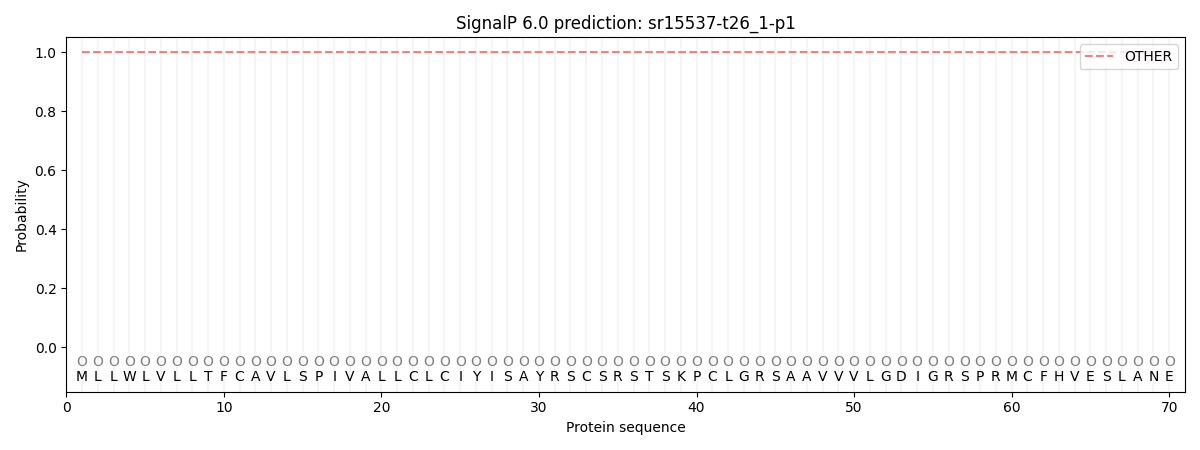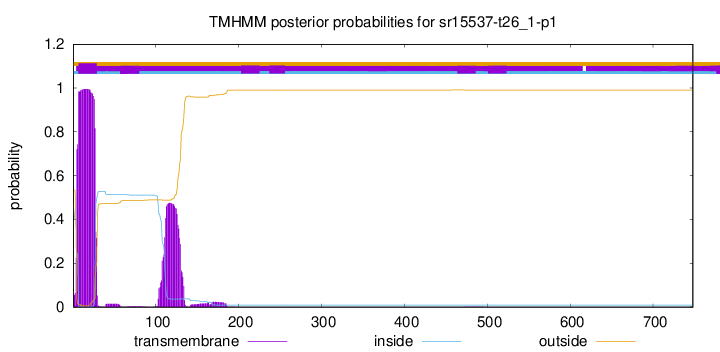You are browsing environment: FUNGIDB
CAZyme Information: sr15537-t26_1-p1
You are here: Home > Sequence: sr15537-t26_1-p1
Basic Information |
Genomic context |
Full Sequence |
Enzyme annotations |
CAZy signature domains |
CDD domains |
CAZyme hits |
PDB hits |
Swiss-Prot hits |
SignalP and Lipop annotations |
TMHMM annotations
Basic Information help
| Species | Sporisorium reilianum | |||||||||||
|---|---|---|---|---|---|---|---|---|---|---|---|---|
| Lineage | Basidiomycota; Ustilaginomycetes; ; Ustilaginaceae; Sporisorium; Sporisorium reilianum | |||||||||||
| CAZyme ID | sr15537-t26_1-p1 | |||||||||||
| CAZy Family | GT2 | |||||||||||
| CAZyme Description | related to ALG1-beta-mannosyltransferase | |||||||||||
| CAZyme Property |
|
|||||||||||
| Genome Property |
|
|||||||||||
| Gene Location | ||||||||||||
Enzyme Prediction help
| EC | 2.4.1.142:10 | 2.4.1.-:1 |
|---|
CAZyme Signature Domains help
| Family | Start | End | Evalue | family coverage |
|---|---|---|---|---|
| GT33 | 45 | 519 | 8.2e-133 | 0.9105882352941177 |
CDD Domains download full data without filtering help
| Cdd ID | Domain | E-Value | qStart | qEnd | sStart | sEnd | Domain Description |
|---|---|---|---|---|---|---|---|
| 340843 | GT33_ALG1-like | 2.27e-140 | 44 | 518 | 4 | 376 | chitobiosyldiphosphodolichol beta-mannosyltransferase and similar proteins. This family is most closely related to the GT33 family of glycosyltransferases. The yeast gene ALG1 has been shown to function as a mannosyltransferase that catalyzes the formation of dolichol pyrophosphate (Dol-PP)-GlcNAc2Man from GDP-Man and Dol-PP-Glc-NAc2, and participates in the formation of the lipid-linked precursor oligosaccharide for N-glycosylation. In humans ALG1 has been associated with the congenital disorders of glycosylation (CDG) designated as subtype CDG-Ik. |
| 215155 | PLN02275 | 1.14e-124 | 44 | 518 | 5 | 371 | transferase, transferring glycosyl groups |
| 340816 | Glycosyltransferase_GTB-type | 3.47e-05 | 402 | 504 | 139 | 235 | glycosyltransferase family 1 and related proteins with GTB topology. Glycosyltransferases catalyze the transfer of sugar moieties from activated donor molecules to specific acceptor molecules, forming glycosidic bonds. The acceptor molecule can be a lipid, a protein, a heterocyclic compound, or another carbohydrate residue. The structures of the formed glycoconjugates are extremely diverse, reflecting a wide range of biological functions. The members of this family share a common GTB topology, one of the two protein topologies observed for nucleotide-sugar-dependent glycosyltransferases. GTB proteins have distinct N- and C- terminal domains each containing a typical Rossmann fold. The two domains have high structural homology despite minimal sequence homology. The large cleft that separates the two domains includes the catalytic center and permits a high degree of flexibility. |
| 404467 | Glyco_trans_4_4 | 3.53e-05 | 64 | 219 | 11 | 142 | Glycosyl transferase 4-like domain. |
| 340831 | GT4_PimA-like | 1.29e-04 | 401 | 527 | 213 | 340 | phosphatidyl-myo-inositol mannosyltransferase. This family is most closely related to the GT4 family of glycosyltransferases and named after PimA in Propionibacterium freudenreichii, which is involved in the biosynthesis of phosphatidyl-myo-inositol mannosides (PIM) which are early precursors in the biosynthesis of lipomannans (LM) and lipoarabinomannans (LAM), and catalyzes the addition of a mannosyl residue from GDP-D-mannose (GDP-Man) to the position 2 of the carrier lipid phosphatidyl-myo-inositol (PI) to generate a phosphatidyl-myo-inositol bearing an alpha-1,2-linked mannose residue (PIM1). Glycosyltransferases catalyze the transfer of sugar moieties from activated donor molecules to specific acceptor molecules, forming glycosidic bonds. The acceptor molecule can be a lipid, a protein, a heterocyclic compound, or another carbohydrate residue. This group of glycosyltransferases is most closely related to the previously defined glycosyltransferase family 1 (GT1). The members of this family may transfer UDP, ADP, GDP, or CMP linked sugars. The diverse enzymatic activities among members of this family reflect a wide range of biological functions. The protein structure available for this family has the GTB topology, one of the two protein topologies observed for nucleotide-sugar-dependent glycosyltransferases. GTB proteins have distinct N- and C- terminal domains each containing a typical Rossmann fold. The two domains have high structural homology despite minimal sequence homology. The large cleft that separates the two domains includes the catalytic center and permits a high degree of flexibility. The members of this family are found mainly in certain bacteria and archaea. |
CAZyme Hits help
| Hit ID | E-Value | Query Start | Query End | Hit Start | Hit End |
|---|---|---|---|---|---|
| 0.0 | 1 | 748 | 1 | 748 | |
| 0.0 | 1 | 748 | 1 | 749 | |
| 0.0 | 1 | 748 | 1 | 739 | |
| 0.0 | 1 | 746 | 1 | 754 | |
| 2.62e-310 | 1 | 747 | 1 | 795 |
Swiss-Prot Hits download full data without filtering help
| Hit ID | E-Value | Query Start | Query End | Hit Start | Hit End | Description |
|---|---|---|---|---|---|---|
| 1.30e-80 | 46 | 513 | 7 | 412 | UDP-glycosyltransferase TURAN OS=Arabidopsis thaliana OX=3702 GN=TUN PE=2 SV=1 |
|
| 2.51e-73 | 44 | 524 | 33 | 430 | Chitobiosyldiphosphodolichol beta-mannosyltransferase OS=Mus musculus OX=10090 GN=Alg1 PE=1 SV=3 |
|
| 2.22e-72 | 44 | 524 | 33 | 430 | Chitobiosyldiphosphodolichol beta-mannosyltransferase OS=Pongo abelii OX=9601 GN=ALG1 PE=2 SV=1 |
|
| 1.16e-71 | 44 | 524 | 33 | 430 | Chitobiosyldiphosphodolichol beta-mannosyltransferase OS=Homo sapiens OX=9606 GN=ALG1 PE=1 SV=2 |
|
| 1.28e-66 | 47 | 529 | 5 | 425 | Chitobiosyldiphosphodolichol beta-mannosyltransferase OS=Dictyostelium discoideum OX=44689 GN=alg1 PE=2 SV=1 |
SignalP and Lipop Annotations help
This protein is predicted as OTHER

| Other | SP_Sec_SPI | CS Position |
|---|---|---|
| 1.000031 | 0.000029 |

